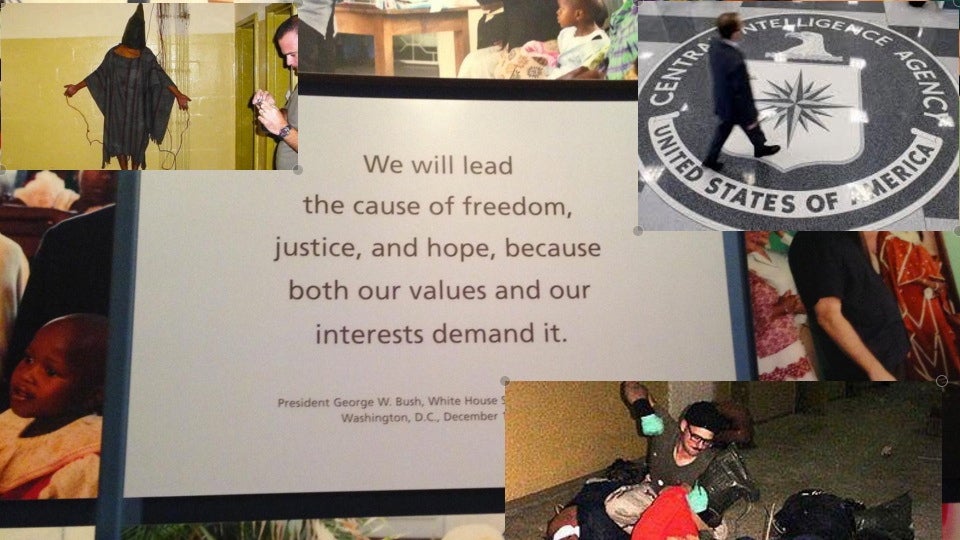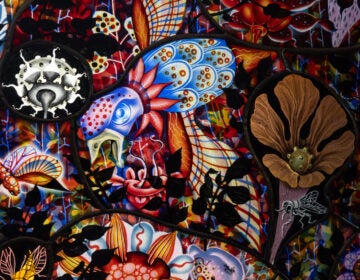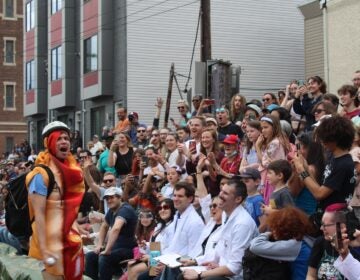With new app, Philly woman adds criticism, complexity to museum’s chronicle of Bush years
Listen
Ellen Chenoweth added images of abuse at the Abu Ghraib prison to a quote at the George W. Bush Presidential Library
If you ever find yourself on the campus of Southern Methodist University in Dallas, you might visit the George W. Bush Presidential Library and Museum.
The 15-acre complex is an archive and exhibition space for the 43rd president’s eight years in office, including the 2000 election recount against Al Gore, the global war on terrorism, Hurricane Katrina, the PATRIOT Act, and the Glock held in the lap of Saddam Hussein when he was captured in 2003.
While there, your cell phone could tell a different story about those years, through an augmented reality museum hack.
Ellen Chenoweth, a Philadelphia arts writer, grew up in Texas. When the George W. Bush library opened in 2013, her mother called to say she was appalled by its interpretation of the Bush years.
“Bush as an environmentalist. Bush’s heroic response to Hurricane Katrina. It’s just amazing the kind of version of history they are putting forward there,” said Chenoweth.
In the early 2000s, Chenoweth had spent time as an activist demonstrating against Bush’s military actions in Iraq and Afghanistan, and the global war on terrorism. She was concerned that the exhibits make no mention of popular dissent.
“For the Iraq War, there was no sense that there had been any opposition to that war,” said Chenoweth. “No hint that millions of people marched in the streets, no hint of the human and financial costs of the war.”
As a form of protest, she added all that additional information to the exhibits herself, through augmented reality. Chenoweth created a smartphone app through an AR service called Layar. When you point your phone at 10 selected exhibits in the library, images, text, charts, and links complicating the official narrative pop up on the screen.
The exhibit about the PATRIOT Act explains that Bush allowed “key intelligence to be shared by law enforcement officials.” In response, Chenoweth added a link to the Twitter feed of Edward Snowden, the former CIA employee who exposed the National Security Administration’s massive collection of data from ordinary citizens.
For Hurricane Katrina, the exhibition quotes Bush saying, “We will do what it takes, for as long as it takes” to rebuild the New Orleans region. The president was widely criticized for his slow, weak response to the natural disaster.
“Presidential libraries, in general, are sites of real public education about American history,” said Chenoweth. “They have hundreds of thousands of visitors a year. Schoolchildren go on field trips to presidential libraries. I think it’s important that the version put out there in the world is complex, nuanced, and multifaceted.”
According to its website, the George W. Bush library receives about 340,000 visitors a year.
There are 22 presidential libraries in the U.S., 13 of them (representing every president since Herbert Hoover) are administered by the National Archives and Records Administration, often through partnerships with private foundations. In the case of the George W. Bush library, NARA partnered with Southern Methodist University, the George W. Bush Foundation, and the George W. Bush Institute.
“They are these funny mixes of private and public. Those purposes are really at odds with each other in a lot of cases,” said Chenoweth.
Many people have created subversive museum audio guides as downloadable podcasts, but few have done it in augmented reality. For example, in 2014 a group of architects created a rogue gallery of architectural designs on top of the Rem Koolhaas pavilion at the Venice Biennale.
Chenoweth was inspired by the 2014 museum hack at the Museum of Modern Art in New York, where a dancer created an unsanctioned AR installation to protest MOMA’s decision to deaccession the papers of the early 20th century choreographer Ted Shawn.
The George W. Bush Presidential Library Augmented Reality Project will be available for a year. But if it goes viral, Chenoweth said, she’ll keep it going.
WHYY is your source for fact-based, in-depth journalism and information. As a nonprofit organization, we rely on financial support from readers like you. Please give today.





